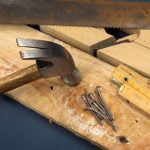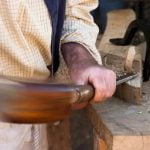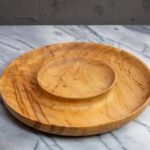Are you interested in learning how to design woodworking projects? Designing your own woodworking projects can be a rewarding and fulfilling experience. Whether you’re a beginner or an experienced woodworker, understanding the basics of woodworking project design is essential for creating successful and functional pieces. From choosing the right wood to incorporating creativity into your designs, there are many factors to consider when embarking on a new project.
In this article, we will explore the key components of designing woodworking projects, providing valuable insights and tips for creating unique and personalized pieces. We will discuss the importance of selecting the right wood for your project, as well as the essential tools and equipment needed for successful design. Additionally, we will delve into the significance of detailed planning and sketching, problem-solving techniques, safety precautions, and expert tips from seasoned woodworkers.
Understanding the fundamentals of woodworking project design is crucial for achieving quality results. By following the comprehensive guide in this article, you will gain valuable knowledge and skills to embark on your own woodworking projects with confidence and creativity. Whether you’re looking to build furniture, decorative items, or functional pieces, this article will provide you with the necessary tools to kickstart your woodworking journey.
Choosing the Right Wood
When it comes to designing woodworking projects, one of the most important factors to consider is the type of wood that will be used. The choice of wood can significantly impact the final outcome of your project, so it’s crucial to carefully consider several key factors before making a decision.
Wood Type
The first thing to consider when choosing the right wood for your woodworking project is the type of wood itself. Different types of wood have different characteristics and are suitable for different purposes. For example, hardwoods like oak and maple are known for their strength and durability, making them ideal for furniture and cabinets. On the other hand, softwoods like pine and cedar are easier to work with and are often used for projects like outdoor decking and fences.
Wood Grade
Another important factor to consider is the grade of the wood. Wood is typically graded based on its appearance and quality, with higher grades being more expensive but also offering better aesthetics and fewer flaws. Understanding the different grades of wood will help you make an informed decision based on your budget and aesthetic preferences.
Moisture Content
Finally, it’s essential to consider the moisture content of the wood. Wood that is too wet or too dry can lead to problems such as warping or cracking once it’s been shaped and assembled into a project. Ensuring that the wood has been properly dried and acclimated to your workshop environment is crucial for a successful woodworking project.
By carefully considering these factors when choosing the right wood for your woodworking project, you can ensure that your finished creation looks beautiful, performs well, and stands the test of time. Whether you’re building a piece of furniture or crafting decorative items, selecting the right wood is a vital step in creating a successful woodworking project.
Tools and Equipment
When it comes to designing woodworking projects, having the right tools and equipment is essential for a successful outcome. Whether you’re a beginner or a seasoned woodworker, having the appropriate tools can make the design process smoother and more efficient. Here are some essential items that you’ll need to have in your workshop:
- Measuring tools: Accurate measurements are crucial in woodworking projects. Invest in a good quality tape measure, combination square, and straight edge ruler to ensure precision in your designs.
- Cutting tools: A set of high-quality saws including a circular saw, jigsaw, and hand saw will be necessary for cutting wood to the desired shapes and sizes.
- Joinery tools: To connect different pieces of wood together, you’ll need tools such as chisels, hand planes, and routers for creating joints like dovetails, mortise and tenon, or dado.
- Sanding equipment: A random orbital sander or sanding block will help smoothen the surfaces of your woodworking projects before applying finishes.
- Finishing tools: Brushes, rollers, sprayers, and finishing materials such as varnish, stain, or paint are essential for adding the final touches to your designs.
Having these tools at your disposal will enable you to design woodworking projects with ease and precision. Additionally, it’s important to invest in high-quality items that will last long-term and produce professional results.
In addition to these basic tools, consider investing in safety equipment such as goggles, gloves, ear protection, and a dust mask to protect yourself while working with wood. With the right tools and safety gear in place, you’ll be well-equipped to tackle any woodworking project with confidence.
Planning and Sketching
Designing woodworking projects begins with careful planning and precise sketching. This section will discuss the critical importance of detailed blueprints and accurate measurements in creating successful woodworking projects.
Understanding the Importance of Detailed Blueprints
A detailed blueprint serves as the roadmap for your woodworking project. It provides you with a clear vision of the final product, helping you to visualize the steps involved in its construction. A well-thought-out blueprint also allows you to anticipate any potential challenges and plan for them accordingly.
Accurate Measurements Matter
Precise measurements are crucial for ensuring that all components of your woodworking project fit together seamlessly. Even a small discrepancy in measurements can lead to major issues during assembly, so taking the time to measure accurately is imperative. Whether using conventional measuring tools or digital options, accuracy should always be the top priority.
Taking Time for Thorough Planning
Thorough planning and sketching can make all the difference between a successful woodworking project and a disappointing one. Before starting any construction, take adequate time to create detailed blueprints and carefully measure each component. This initial investment of time will ultimately save you from frustration and mistakes down the road, resulting in a more polished finished product.
Incorporating Creativity
When it comes to woodworking projects, incorporating creativity can take your designs to the next level. Adding unique and personal touches to your projects not only makes them stand out, but also gives you a sense of pride and satisfaction in your work. But how exactly can you add that creative flair to your woodworking designs?
One way to inject creativity into your woodworking projects is by choosing distinct wood grains and textures. Each type of wood has its own unique characteristics, so selecting the right wood for your project can add a special touch. Another way to get creative is by incorporating different joinery techniques. Whether it’s dovetail joints, mortise and tenon joints, or biscuit joints, the way you connect pieces together can make a big impact on the overall look of your project.
In addition to this, adding custom details such as inlays, carvings, or engravings can bring a touch of personality to your woodworking designs. These small details can make a big difference in the final outcome of your project. Ultimately, allowing yourself room for experimentation and embracing imperfections along the way will lead to truly original and unique woodworking projects.
| Woodworking Project Design Tip | Description |
|---|---|
| Distinct Wood Grains and Textures | Choosing unique wood grains and textures can add a special touch to your woodworking projects. |
| Different Joinery Techniques | Incorporating various joinery techniques such as dovetail joints or mortise and tenon joints can enhance the overall look of your designs. |
| Custom Details | Adding custom details like inlays or carvings can give a personal touch to your woodworking projects. |
Problem-Solving
Designing woodworking projects can be a rewarding but challenging endeavor. Knowing how to overcome common design challenges in woodworking is essential for ensuring the success of your projects. Here are some tips and techniques to help you navigate through these obstacles:
- Measure Twice, Cut Once: One of the most common design challenges in woodworking is inaccurate measurements. To avoid costly mistakes, always double-check your measurements before making any cuts. Invest in high-quality measuring tools and take your time to ensure precision.
- Wood Selection: Choosing the right type of wood for your project is crucial. Different woods have varying strengths, weaknesses, and appearances. Consider factors such as durability, grain pattern, and ease of working with the wood when making your selection.
- Joinery Techniques: Joinery is an important aspect of woodworking design, but it can also pose challenges. Ensure that you have a solid understanding of different joinery techniques such as mortise and tenon, dovetail, and biscuit joints. Practice these techniques to master them before incorporating them into your projects.
Another important aspect of problem-solving in woodworking projects is being prepared for unexpected issues that may arise during the construction process. Here are a few more tips on how to handle those unforeseen challenges:
- Adaptability: Remain flexible and open-minded when faced with unexpected challenges. Sometimes plans need to be adjusted on the fly, so having a solution-oriented mindset will help you overcome these hurdles.
- Patience: Woodworking requires patience and perseverance, especially when dealing with unexpected difficulties. Take a step back, reassess the situation, and approach the problem calmly and methodically.
- Seek Advice: Don’t hesitate to seek advice from experienced woodworkers or online communities if you encounter a design challenge that you’re unsure how to tackle. Learning from others’ experiences can provide valuable insights and solutions.
By implementing these problem-solving strategies into your woodworking endeavors, you’ll be better equipped to handle common design challenges and ultimately create successful projects that showcase your skills and creativity.
Safety First
Woodworking can be a fulfilling and rewarding hobby, but it’s important to prioritize safety when designing and creating woodworking projects. Whether you’re a beginner or an experienced woodworker, following important safety precautions and guidelines is crucial to prevent accidents and injuries in the workshop.
When working with power tools, it’s essential to wear appropriate personal protective equipment (PPE) such as safety goggles, hearing protection, and a dust mask. These items will help protect your eyes, ears, and respiratory system from potential hazards such as flying debris, loud noise, and wood dust. Additionally, wearing close-fitting clothing and avoiding loose jewelry can help prevent accidents involving clothing getting caught in moving parts of machinery.
In addition to using the right PPE, it’s important to maintain a clean and organized workspace. Cluttered work areas can increase the risk of tripping or falling, so be sure to keep tools and materials neatly stored when not in use.
It’s also important to have proper ventilation in your workshop to minimize exposure to harmful dust and fumes that may result from woodworking activities. Lastly, always read and follow the manufacturer’s instructions for all tools and equipment used in your woodworking projects to ensure safe usage.
Expert Tips and Techniques
Woodworking is a craft that requires careful planning, precise execution, and a keen eye for design. Seasoned woodworkers have a wealth of knowledge and experience that can be invaluable to those just starting out in the craft. Here are some expert tips and techniques from seasoned woodworkers on designing successful projects.
One important piece of advice from experienced woodworkers is to always start with a clear vision of what you want to create. Whether it’s a simple shelf or an intricate piece of furniture, having a clear idea of the end result will guide your design process. Consider the function of the piece, its intended location, and any specific requirements or preferences you may have. This initial step will set the stage for a well-planned and successful woodworking project.
Another valuable tip from seasoned woodworkers is to embrace creativity in your designs. While it’s important to follow fundamental woodworking principles, adding unique and personal touches can turn a simple project into something extraordinary. Experiment with different finishes, joinery techniques, or decorative elements to make your designs stand out.
Additionally, seasoned woodworkers emphasize the importance of patience and persistence when facing design challenges. It’s normal to encounter obstacles along the way, such as fitting pieces together seamlessly or achieving desired proportions. Overcoming these challenges often leads to valuable learning experiences and improves your overall skills as a woodworker.
| Expert Tips | Techniques |
|---|---|
| Start with a clear vision | Embrace creativity |
| Be patient and persistent | Learn from design challenges |
Conclusion
In conclusion, designing woodworking projects can be a rewarding and fulfilling experience for both beginners and seasoned woodworkers. By understanding the basics of woodworking project design, choosing the right wood, and having the essential tools and equipment, anyone can embark on their own creative journey. Planning and sketching with detailed blueprints and measurements are crucial to the success of any woodworking project, as it ensures accuracy and precision in the final outcome.
Moreover, incorporating creativity is key to adding unique and personal touches to designs. Whether it’s through intricate carvings or personalized finishes, infusing your personality into your work can make each project truly special. It’s important to also be prepared for common design challenges in woodworking and to approach them with problem-solving skills.
Finally, safety should always come first when undertaking any woodworking project. Following important safety precautions and guidelines will ensure a safe working environment. As readers are encouraged to start designing their own woodworking projects, they should also seek advice from seasoned woodworkers for expert tips and techniques. With dedication, practice, and attention to detail, anyone can create stunning woodworking projects that they can take pride in.
Frequently Asked Questions
How Do You Plan a Woodwork Project?
Planning a woodworking project involves several key steps. First, you need to decide on the type of wood and materials you will use based on the project’s requirements. Then, sketch out the design and create a cut list for all the pieces needed.
It’s important to carefully measure and mark the wood before cutting, and always double-check your measurements to avoid mistakes. Assembling the project will require careful attention to detail, using clamps or other tools as necessary. Finally, applying a finish or sealant will complete the project.
Is SketchUp Good for Woodworking?
SketchUp can be a valuable tool for woodworking projects. Its 3D modeling capabilities allow you to visualize the final product before making any cuts, which can help prevent errors in construction. Additionally, SketchUp provides precise measurements and angles, helping woodworkers plan their projects more accurately.
What Are the Important Things to Remember When Designing a Wooden Project?
When designing a wooden project, it’s important to first consider its function and purpose, ensuring that the design meets these needs effectively. It’s crucial to take accurate and detailed measurements before starting any construction, minimizing errors during assembly.
Additionally, paying attention to grain direction when cutting wood can impact both aesthetics and structural integrity. Lastly, considering how different finishes or joinery methods will affect the overall look and durability of the project is essential for successful woodworking design.

Hi everyone! I’m a woodworker and blogger, and this is my woodworking blog. In my blog, I share tips and tricks for woodworkers of all skill levels, as well as project ideas that you can try yourself.





